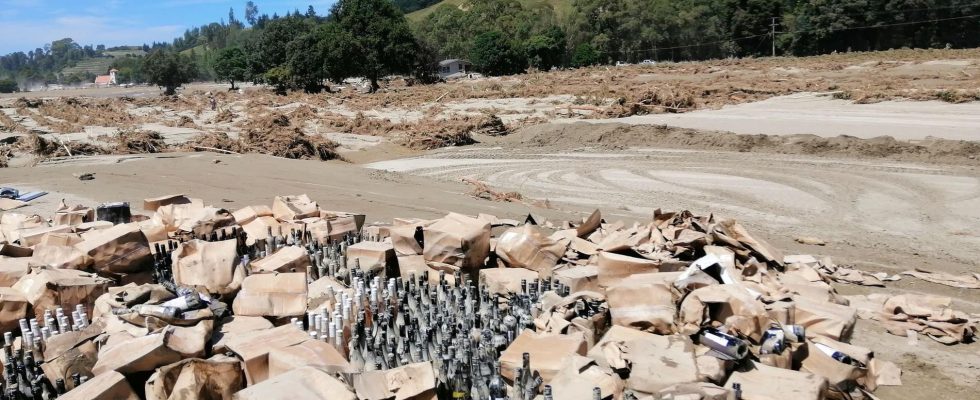Published: Less than 20 min ago
1 of 6 Photo: Petane/TT
The vines are destroyed, most of the machinery as well and this year’s harvest has gone up in smoke. Cyclone Gabrielle has devastated several vineyards in New Zealand.
But in the devastation there is a small glimmer of light. Tens of thousands of bottles have been dug up from the mud left behind by the cyclone.
It is hard to imagine the devastation in the Esk Valley, in Hawke’s Bay on the eastern side of New Zealand’s North Island.
What used to be a picturesque vineyard landscape is now covered in mud.
– Sometimes you see news reports and posts on social media that are exaggerated. But this is just as bad as it looks, says Hana Montaperto-Hendry, who makes the wine Saorsa, and continues:
– It’s like we’re immersed in a mud bath that you can’t get out of.
“Continued to rise”
When Cyclone Gabrielle reached New Zealand on February 12, it was with strong winds and torrential rain.
Philip Barber runs the Petane vineyard in the Esk Valley, which he and his family built up over 16 years. He was prepared for the water to rise with the storm, and had prepared with sandbags to protect the basement of the apartment building.
– But the water continued to rise, and we thought that this is not normal. Then the water started to come up from the shower and over the basement windows, he tells TT.
In the end, the family, with a three-year-old and a five-year-old, was forced to climb onto the roof of the three-story building.
– We sat there for four hours, from four in the morning, and it got worse and worse. A whole log came floating and slammed into the house so that it shook.
– A tractor shed was torn apart, the tractor floated away. We were like in the middle of a huge, raging river.
At six o’clock the climax was reached. Then the sun looked forward. After a while the water receded and the family was eventually able to jump down to the ground and get to friends. What remained was mud, sludge and devastation.
– In the last week, we have gone back to the house, to the brewery, to the restaurant and to the vineyard and saved what we can. People – some strangers – have turned up with shovels to help, he says.
The five-hectare vineyard is destroyed.
– It will take five to six years before you have a vineyard here again, if I choose to do so. Maybe I’ll do something else, maybe this is the end of an era, he says.
– We dig out of the mud and wait for the insurance companies, he says.
Hana Montaperto-Hendry says that a small part of her vineyard, the highest located, may survive. Normally, she harvests 15-20 tons of grapes.
– We might be able to get one to two tonnes of fruit from it if it stops raining. The rest is destroyed, it cannot be saved. We need bulldozers and trucks to haul away all the sludge and dead vines before we can replant. It will take years, she says.
In addition, all machinery and vehicles used for winemaking are destroyed.
Lots of bottles
But as so often in disasters, people have shown their best side. People get in touch, come and help in a true spirit of cooperation. Another bright spot for growers in the Esk Valley is the amount of wine bottles that have been dug out of the sludge or found floating in the water.
– It took two days for 15 to 20 people to dig them out, says Philip Barber, who found 12,000 bottles.
– Some labels are quite dirty, so we are cleaning and sanitizing, but we seem to be able to save the wine.
Much of Hana Montaperto-Hendry and husband Alex Hendry’s wine also seems to have made it.
– The work is ongoing. We are talking about tens of thousands of bottles. I may be exaggerating a little, but there are many, she says.
There are plans to auction the bottles in Auckland. Private individuals and restaurants have also contacted us about wine purchases, which can mean financial relief.
No victim
Hana Montaperto-Hendry refuses to see herself as a victim. She says that everything will be rebuilt, that the Esk Valley will once again become a wind valley. She points out that other growers in the rest of Hawke’s Bay have done better and that they promised to put up machines and help.
– We have a lot of support, it’s fantastic, we will continue, she says.
Perhaps there is also a future for Petane. Philip Barber may be able to buy grapes from other farms. And although he still wakes up with nightmares of being in the river water with his children, he is grateful.
– We are lucky to be alive, he says.
Facts
Cyclone Gabrielle
Cyclone Gabrielle moved across New Zealand from 12 February causing great devastation.
At least eleven people died in the storm, which caused landslides and floods. Hundreds of thousands were without power, roads were destroyed and thousands of people were forced to leave their homes.
Initially, 6,000 people could not be reached, a figure that had dropped to eight two weeks later.
The Hawke’s Bay and Gisborne wine regions, the country’s second and third largest regions respectively, were hit hard in parts by Gabrielle. Some vineyards are completely destroyed, while others managed relatively well. Last year, the regions accounted for 60,000 tonnes of wine, which corresponds to 12 percent of the country’s production.
Read more
